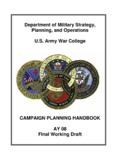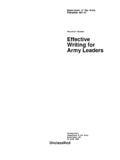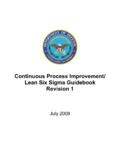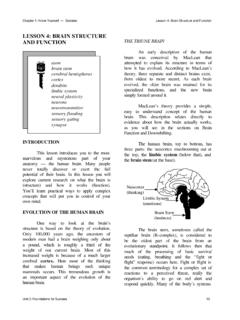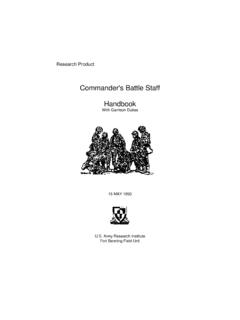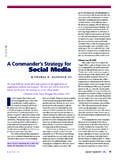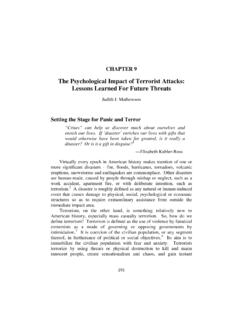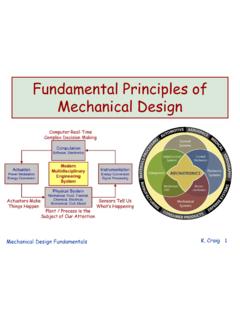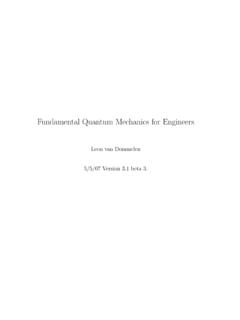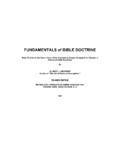Transcription of THINKING CRITICALLY ABOUT CRITICAL THINKING: A …
1 THINKING CRITICALLY ABOUT CRITICAL THINKING : A FUNDAMENTAL GUIDE FOR STRATEGIC LEADERS Colonel (Retired) Stephen J. Gerras, Professor of Behavioral Sciences Department of Command, Leadership, & Management Army War College August 2008 The views expressed in this paper are those of the author and do not reflect the official policy or position of the Department of the Army, Department of Defense, or the Government. 2 THINKING CRITICALLY ABOUT CRITICAL THINKING : A FUNDAMENTAL GUIDE FOR STRATEGIC LEADERS Technological advances alone do not constitute change.
2 The most dramatic advances in military operations over history have been borne of ideas ideas ABOUT warfighting, organization and doctrine. The Army s most CRITICAL asset will not be technology; it will be CRITICAL THINKING . 1 AUSA Torchbearer National Security Report, March 2005 Most Army schools open with the standard bromide: We are not going to teach you what to are going to teach you how to think. They rarely do. 2 BG David A. Fastabend and Robert H. Simpson, February 2004 In the post Cold War security environment many senior leaders in the Army and throughout the Department of Defense have asserted a need to develop better CRITICAL THINKING The requirement for better CRITICAL thinkers stems from a realization that the complexity, uncertainty, and ambiguity characteristic of the current environment mandates a need to refrain from Cold-War THINKING methodologies and assumptions.
3 As the epigraphs (above) suggest, there is a large gap between the Army s desire to develop CRITICAL THINKING skills and what actually happens. This gap is due not only to a general lack of understanding of what CRITICAL THINKING is, but also a lack of education by both faculty and Army leadership on how to develop CRITICAL thinkers. The purpose of this paper is to analyze the concept of CRITICAL THINKING and then make suggestions for how the Army can close the gap between the need to develop CRITICAL thinkers and what is actually happening.
4 This paper is not just for Training and Doctrine Command (TRADOC) organizations; rather, it is to serve leaders throughout the Army in their efforts to develop their own CRITICAL THINKING skills, while creating a climate that develops the same skills in their subordinates. This document is a user s guide to CRITICAL THINKING . Most of the contexts, examples, and recommendations are Army-centric, although everything in this paper is applicable to all military services and governmental organizations. One of the main impediments to the robust understanding and use of CRITICAL THINKING , both inside and outside the military, centers on a lack of a common definition.
5 No one discipline owns the construct. Most of the material ABOUT CRITICAL THINKING derives from philosophy, education, and There are, however, competing schools of thought on what CRITICAL THINKING is and how to best develop it. In most cases a multidisciplinary assessment of a topic leads to a richer body of research, however, in the case of CRITICAL THINKING it seems to have led to competing and 3 incomplete views of the topic. My goal is not to evaluate various views of CRITICAL THINKING . Instead, I hope to provide a guide with which to enhance an individual s CRITICAL THINKING skills.
6 As a starting point, I will use Diane Halpern s broad definition of CRITICAL THINKING as a foundation: CRITICAL THINKING is the use of those cognitive skills or strategies that increase the probability of a desirable outcome. It is used to describe THINKING that is purposeful, reasoned, and goal directed. 5 In essence, CRITICAL THINKING is ABOUT improving one s judgment. Whether we are evaluating the information on a power point slide in a Pentagon briefing, reading a newspaper article, or participating in a discussion with an Iraqi mayor, CRITICAL THINKING is the deliberate, conscious, and appropriate application of reflective skepticism.
7 Some Army leaders refer to the CRITICAL in CRITICAL THINKING as mere fault finding with either a conclusion or the process by which a conclusion was reached. Fault finding is not what CRITICAL THINKING entails. The word CRITICAL really has to do with purposeful, reflective and careful evaluation of information as a way to improve one s judgment. The question is, How do we develop these judgment skills in Army leaders? One way is to teach logic and reasoning skills that are typically the focus of philosophy. Another way is to emphasize questioning and self-reflection skills that are usually the focus of education and Additionally, there are generally two schools of thought on how to develop CRITICAL THINKING skills: context-free and context-dependent.
8 Context-free development focuses upon teaching CRITICAL THINKING skills irrespective of any specific subject. Context-dependent development centers on teaching the same skills but with a particular field of study. Based on my experience at the War College, I think the best way to teach CRITICAL THINKING skills to military leaders is to provide context-dependent skill development that incorporates both the CRITICAL reasoning contributions of philosophy with the questioning and self-reflection focus from the fields of education and psychology.
9 Therefore, I argue that CRITICAL THINKING skills are best developed by: (1) providing knowledge from a multidisciplinary perspective ABOUT CRITICAL THINKING skills, (2) practicing the application of these skills in a context-dependent setting under the purview of a facilitator or knowledgeable leader, and (3) creating a healthy environment, in both TRADOC schools and organizational units, that encourages and motivates a desire to routinely apply CRITICAL THINKING skills to important issues. The next section of this paper describes a general model that serves as a starting point for developing a lexicon, context, and mental template for the development and application of CRITICAL THINKING for developing strategic leaders.
10 4 A CRITICAL THINKING Model This paper provides a model and accompanying terminology to inform the military community of a way to look at CRITICAL THINKING . Whether in a lunchtime conversation with a friend ABOUT democracy in the Middle East, or developing courses of action in Iraq within the structure of the military decision making process (MDMP) a well-developed CRITICAL thinker will mentally ensure his thought process is not proceeding down the road without due application of reflective skepticism. Renowned CRITICAL THINKING experts Paul and Elder assert: A well-cultivated CRITICAL thinker raises vital questions and problems, gathers and assesses relevant information, and can effectively interpret it; comes to well-reasoned conclusions and solutions, testing them against relevant criteria and standards; thinks open-mindedly within alternative systems of thought, recognizing and assessing, as need be, their assumptions, implications, and practical consequences.
